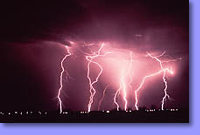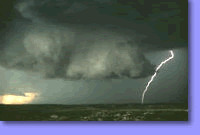T H U
N D E R A N D L I G H T N I N G
 Thunder
and lightning have impressed humans with their spectacle and violent results
from the earliest times. The Greeks thought it was their high god Zeus who threw
lightning bolts. The Vikings said their main deity, Thor, struck lightning by
hammering an anvil while traveling by chariot across the sky. Native Americans
believed that the "Thunderbird" flapping its wings created the sound of thunder
and that its bright feathers were the source of lightning flashes. For young
children, thunder and lightning are still some of the most frightening weather
phenomena. But nearly 2 centuries of research on thunder and lightning have
helped us understand a lot about what causes them.
Thunder
and lightning have impressed humans with their spectacle and violent results
from the earliest times. The Greeks thought it was their high god Zeus who threw
lightning bolts. The Vikings said their main deity, Thor, struck lightning by
hammering an anvil while traveling by chariot across the sky. Native Americans
believed that the "Thunderbird" flapping its wings created the sound of thunder
and that its bright feathers were the source of lightning flashes. For young
children, thunder and lightning are still some of the most frightening weather
phenomena. But nearly 2 centuries of research on thunder and lightning have
helped us understand a lot about what causes them.
Thunderstorms bring several different kinds of dangerous weather: tornadoes,
hail, flash floods, and, of course, lightning. Flash
floods (also caused by the drenching rain of hurricanes) are the #1
cause of weather fatalities in the United States, and lightning is #2, with
more than 100 deaths per year. Lightning injures hundreds more, and causes millions
of dollars worth of damage. Hail can wreck whole fields of crops in minutes.
At any one time
some 1,000 to 2,000 thunderstorms are going on somewhere around Earth. Researches
using satellites to get a global picture now estimate there may be some 100
lightning flashes a second!
 To
grow, thunderstorms need unstable air, with warm air near the ground and cold
air up above. While these kinds of storms can occur at any time of year, they're
more frequent in spring and summer. They're "convective storms", meaning that
in them warm air rises, releases heat energy and cools, and then falls down
once again, like soup boiling on a stove.
To
grow, thunderstorms need unstable air, with warm air near the ground and cold
air up above. While these kinds of storms can occur at any time of year, they're
more frequent in spring and summer. They're "convective storms", meaning that
in them warm air rises, releases heat energy and cools, and then falls down
once again, like soup boiling on a stove.
Getting a thunderstorm
started requires one of a number of triggering events to set the warm air moving
upwards. It can be the arrival of a cold front—heavier, denser cold air
running into lighter, warm air, and forcing it upwards. Or it can be a local
change in elevation, or some other cause of excessive heating close to the surface.
There are places
across the continent where such conditions are more common, as in the Great
Plains, where there's the so-called "dryline", a frequently-found boundary between
dry air moving east from the deserts of the Southwest and humid air from the
Gulf of Mexico.
 To
understand a thunderstorm it helps to think of the basic building block as being
a "single cell" storm, but in
the real world most thunderstorms are in fact "multi-cell", made up of multiple
cells. Once a thunderstorm has formed, it can trigger other storms as much
as a hundred miles farther away, in a kind of chain reaction, by creating a
gust of cold wind that bumps into this new region of warm air and starts it
moving upwards. At lesser distances, this pulse of cooler air can also trigger
mult-icell thunderstorms.
To
understand a thunderstorm it helps to think of the basic building block as being
a "single cell" storm, but in
the real world most thunderstorms are in fact "multi-cell", made up of multiple
cells. Once a thunderstorm has formed, it can trigger other storms as much
as a hundred miles farther away, in a kind of chain reaction, by creating a
gust of cold wind that bumps into this new region of warm air and starts it
moving upwards. At lesser distances, this pulse of cooler air can also trigger
mult-icell thunderstorms.
The most severe
thunderstorms, known as "supercells",
require special weather conditions, and so appear less frequently. But the United
States is also the place where such conditions can be found most often. "Supercells"
can last for hours, triggering tornadoes.

 Thunder
and lightning have impressed humans with their spectacle and violent results
from the earliest times. The Greeks thought it was their high god Zeus who threw
lightning bolts. The Vikings said their main deity, Thor, struck lightning by
hammering an anvil while traveling by chariot across the sky. Native Americans
believed that the "Thunderbird" flapping its wings created the sound of thunder
and that its bright feathers were the source of lightning flashes. For young
children, thunder and lightning are still some of the most frightening weather
phenomena. But nearly 2 centuries of research on thunder and lightning have
helped us understand a lot about what causes them.
Thunder
and lightning have impressed humans with their spectacle and violent results
from the earliest times. The Greeks thought it was their high god Zeus who threw
lightning bolts. The Vikings said their main deity, Thor, struck lightning by
hammering an anvil while traveling by chariot across the sky. Native Americans
believed that the "Thunderbird" flapping its wings created the sound of thunder
and that its bright feathers were the source of lightning flashes. For young
children, thunder and lightning are still some of the most frightening weather
phenomena. But nearly 2 centuries of research on thunder and lightning have
helped us understand a lot about what causes them. To
grow, thunderstorms need unstable air, with warm air near the ground and cold
air up above. While these kinds of storms can occur at any time of year, they're
more frequent in spring and summer. They're "convective storms", meaning that
in them warm air rises, releases heat energy and cools, and then falls down
once again, like soup boiling on a stove.
To
grow, thunderstorms need unstable air, with warm air near the ground and cold
air up above. While these kinds of storms can occur at any time of year, they're
more frequent in spring and summer. They're "convective storms", meaning that
in them warm air rises, releases heat energy and cools, and then falls down
once again, like soup boiling on a stove.  To
understand a thunderstorm it helps to think of the basic building block as being
a "
To
understand a thunderstorm it helps to think of the basic building block as being
a "